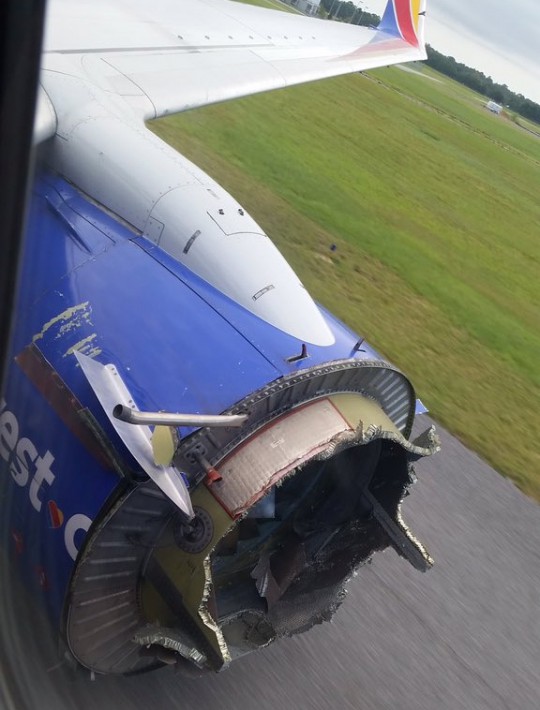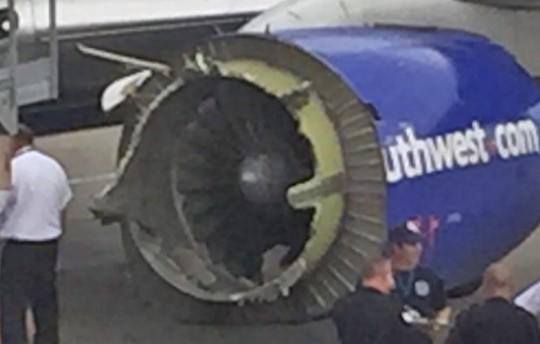Southwest Plane Diverted To Pensacola After ‘Uncontained Engine Failure’
August 28, 2016
A Southwest Airlines flight from New Orleans to Orlando diverted to Pensacola Saturday morning due to a mechanical issue with one of the plane’s engines.
“Today, the Captain of Flight #3472 from New Orleans to Orlando made the decision to divert to Pensacola due to a mechanical issue with the number one engine. The flight landed safely without incident at Pensacola International Airport at 9:40 a.m. central time,” Southwest said in a statement.
The plane experience an “uncontained engine failure”, according to The National Transportation Safety Board.
There were no injuries to any of the 99 passengers or five crew members, Southwest said. Alternative arrangements were made to get the passengers to Orlando.
The aircraft remained out of service in Pensacola awaiting a damage assessment.
Photos courtesy Stephanie/Twitter and Lexy/Twitter.
Comments
15 Responses to “Southwest Plane Diverted To Pensacola After ‘Uncontained Engine Failure’”





Alvin W.—Extremely great explanation! In my experience in refueling airliners, I have seen however, a few arrive with access panel doors open. Worst case was a high wing turbo prop where the pilot complained of low oil pressure. I found the oil cap dipstick laying on top of the engine, next to the blades of a small cooling fan. Open access doors/fasteners were unlikely to be the cause as you state. Southwest officials say no explosion in the usual meaning of that term. Parts coming off at 500 mph & hitting the aircraft, could be considered as an explosive event by some however.
Thankfully, all are safe. I remember the Delta incident, and I also remember an Eastern Airliner almost cracking in half after they landed on the runway in Pensacola. It seems we also had a plane run off into the bay about 20 years ago too.
Everything posted so far is speculation, and will be until the NTSB concludes it’s investigation months from now. However, based on the photos and experience with those components, here is my 2 cents worth. First, the 4 unlatched latches (2 sticking up on the pylon forward apron, and 2 on the pylon access panel) came unlatched as a result of the incident. No flight or ground crew (or passenger sitting in a window seat with a view of that engine) would have missed those latches not being secured. Even if that somehow were the case, WOULD NOT cause the INLET to explode. The forward lip skin (gone, as are both outer panels, the Forward bulkhead, and most of the inner bond panels) has a void between the forward bulkhead and the lip skin that is heated with pressurized air (comes off the engine compressor through that pipe you can see bent back in the one photo) to keep the front of the engine from icing over (Which affects airflow and can break off folding the engine). So my somewhat knowledgable guess is a catastrophic bond panel (the main structure of the inlet and part that looks peeld back) failure is what happened. The other possibility is that their was a severe overpressurization of the lip skin that caused it to explode. But that is less likely, as those particular inlets have vent holes cut into the bottom lip skin for the pressurized anti icing air to exit. All those vent holes would have had to be blocked/ plugged from inside the lip skin for it to overpressurization. If one or both of the outer panels failed & came off, the inner bond panels shouldhave held up, unless the forward lip skin ripped off. Without the outer panels that would have been a possibility. As for the engine damage, that would have been caused by the inlet coming apart. The missing pieces are well forward of the inlet fan, which is the beginning of the actual engine (the fan attaches to the front of the engine).
The engine did not come apart. The actual engine itself, starts at the point in the photos where you see the first stage of turbine compressor blades, & they are now made to have a type of containment feature around the engine, to keep parts from flying outward into the fuselage or other critical areas like fuel tanks. It happened over water, so no pieces went down on land. The large missing piece is strictly only the air intake part of the nacelle, & not any part of the actual engine itself.
A photo on another news site shows a pretty nasty gash in the fuselage under the Windows. Happened at 30000 ft. Would have been much worse if damage had penetrated into the cabin.
“Uncontained Engine Failure” is not PC, it’s the industry term for an event where a piece of the engine does not stay within the nacelle (the thing surrounding the engine). If you look at the photos, you can see the fan’s mostly intact, the engine did not “blow up”. The pictures are poor but it’s not even clear that this was an uncontained failure, it looks like somehow the forward part of the nacelle came apart and was ingested. That could have been caused by an engine failure or the other way around.
Uncontained means it broke through the outer shell of the engine.
The pieces probably landed south and west of Dauphin Island in the Gulf of Mexico; though at that height and speed there are lots of options.
http://www.findlatitudeandlongitude.com/
Plane was at 30.2111 Latitude and – 88.2903 when it slowed and started descent.
http://flightaware.com/live/flight/SWA3472/history/20160827/1400Z/KMSY/KPNS/tracklog
The Delta incident in Pensacola lead to changes that make all flying public more safe.
http://www.ntsb.gov/news/press-releases/Pages/Undetected_Crack_in_Engine_Led_to_Fatal_Delta_Air_Lines_Accident_in_Pensacola_NTSB_Determines.aspx
The full report: http://www.ntsb.gov/investigations/AccidentReports/Reports/AAR9801.pdf
Just an interesting read.
M
Thankfully, there were no injuries aboard the aircraft and it landed safely.
Thankfully, the aircrew kept the damaged plane flying to the airport.
Uncontained engine failure = the damage was not kept within the engine.
In this case it was the forward part of the engine that is missing thus uncontained.
Wonder where those pieces landed?
Note the PC use of “issue” “… due to a mechanical issue with the number one engine.” Bubba, if the engine on anything that I am part of comes apart it is a PROBLEM not an “issue”. Sounds like trying to downplay the situation.
Yes, recalling the passenger killed at the Pensacola Regional Airport some years ago when there was an engine failure sending a piece of a blade into the cabin. That too was a PROBLEM.
I’ll take flying any day. No one expects these man-made engines to never go bad. Take a look at the accidents on the ground around here and I’ll take flying any day. The airlines do an excellent job as far as equipment goes. Look at how fast the pilot put that jet back on the ground, excellent work.
What is an “uncontained” engine failure? Surely the engine did not fall out during the flight. (if so, it could have been a disaster and killed people on the ground)
You’ve got to laugh at the PC comment about what happened. “An uncontained engine failure.” Yeah, the darn thing blew up, so I guess it was uncontained.
Wonder where the rest of the engine landed?
I noticed 3 things that could have been either a cause, or result of the forward engine nacelle cowling to break away. Very noticeable are two red fastener handles in the up & open position on the top, just rear of the break. An open access panel on top (in the white area) at the engine pylon mount, & an open access panel on the right side of the engine. As I stated, these being open, could be caused by the loss of the nose piece. If these were open prior to the loss, they may have contributed or possibly caused the incident, but I am not an aeronautical expert.
Thank God they landed safely! That is quite a large chunk of missing engine and it/parts and pieces are somewhere on the ground in the area.
When the engine breaks apart in this manner the outcome is usually drastic. I remember a Delta plane engine breaking up here years back at the terminal and killing a passenger in her seat.